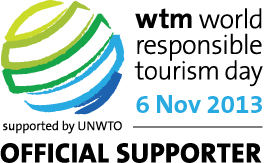
Introduction
During the period of the Mongol Empire shamans were powerful political as well as spiritual advisors. Books, manuals and manuscripts on rites, ancestor worship, chiromancy, dreams, prayers and hymns of Great Shamans and Shamanesses were destroyed by Buddhists during spread of Lamaism and many of their practices and beliefs assimilated in most parts of Mongolia except for Northern one. Specifically, in Lake Khovsgol area the white shamans managed to preserve their true faith and practice. Accepting the new yellow religion of Buddhism they in a way transformed into yellow shamans who were able even to practice in monasteries. One of such monasteries that had shamans practicing was once situated on the border of Mongolia and Buryat Republic of Russia. This was Dayan Derhe Sharavliin Huree located in very close proximity to Khovsgol in the most worshipped place of the entire lake’s area which still remains a holy spot for all locals, shamanism and Lamaism believers alike. The monastery itself was named after the 1-st “Bo” - The Great Shaman Dayan Derhe whose awe-inspiring shamanistic spirit is believed to be still there, in the cave of legendary Dayan Derhi, which will be visited by us during the trip and is one of the highlights that the trip offers.
Lake Khovsgol in Mongolia naturally attracts many photographers and film crews as well as horseback riders. Part of the expedition will be on horseback. Riding horseback in northern Mongolia's Khovsgol Lake National Park through some of the world's most beautiful and pristine wilderness, you can easily imagine riding alongside the warriors of Genghis Khan eight centuries ago. Guided by expert native riders in the "Land of Blue Skies", you'll experience one of the most challenging and wild rides of your life.
On this tour you’re welcome to discover Mongolia’s Best Kept Secret –Lake Khovsgol while following the route of ancient “bo” – the first shamans of Central Asia and Lake Baikal!
The Itinerary Description
Day 1
July, 8 – Welcome to Irkutsk - “Paris of Siberia”, the gateway to “Siberia’s” Pearl - Lake Baikal and Mongolia’s Best Kept Secret –Lake Khovsgol!
Upon arrival we meet you with professional bi-lingual guide holding “Absolute Siberia Bureau” poster, assist with the luggage.
Today we’ll have plenty of time to explore the city’s most atmospheric sights of Irkutsk. During the sightseeing tour we’ll visit the city’s historical center; we will also have opportunities to take pictures of richly carved old-style wooden houses, see the Monument to Russian Pioneers of Siberia topped by the bronze figure of Alexander-the 3rd, the White House of Siberian Province and central market.
Later in the afternoon we will have a guided tour of of the Decembrist Museum at prince Volkonsky Mansion which used to belong in the past to one of the leaders of Decembrist revolutionaries – Russian aristocracy who were banned to Siberia after an ill-fated attempt in December of 1825 to overthrow the Russian Tsar.
Upon return to the hotel enjoy dinner. Overnight at the hotel.
Day 2
July, 9 – en route the two Great Lakes of Asia and two Superior shaman spirits
 On checking the availability of passports and entrance visas we start out by van to the Kultuk settlement, located 110 km away from Irkutsk. With one stop en route to take pictures of splendid views of taiga-woods and scenic lake Baikal in about 1 hour 20 minutes we reach the lake’s southernmost settlement founded by early Russian explorers in 1654. From Kultuk we follow the highway into the beautiful Tunka ( or Tunkinskaya) Valley – the native land of Gesser, a hero from famous Buryat National Epic which ancient mythology, perhaps, is the key to understanding the intricate cosmology of Buryat shamanism. On checking the availability of passports and entrance visas we start out by van to the Kultuk settlement, located 110 km away from Irkutsk. With one stop en route to take pictures of splendid views of taiga-woods and scenic lake Baikal in about 1 hour 20 minutes we reach the lake’s southernmost settlement founded by early Russian explorers in 1654. From Kultuk we follow the highway into the beautiful Tunka ( or Tunkinskaya) Valley – the native land of Gesser, a hero from famous Buryat National Epic which ancient mythology, perhaps, is the key to understanding the intricate cosmology of Buryat shamanism.
The Tunka Valley beginning from the southern end of lake Baikal and nestling between two beautiful snow capped mountain ranges lies wholly within the premises of Tunkinskii National Park. This gorgeous valley with taiga-boreal forests around it being the home to more than 200 mineral springs is considered to be a sacred place by indigenous peoples of Buryats, Soyots and Evenks who jointly with public activists and environmentalists of the Lake Baikal area widely opposed and managed to stop the project to build an oil pipe line here.
After entering the territory of Tunkinskii National Park we stop at a scenic place to take pictures and have some snack with hot tea/ coffee provided.
Then we proceed to Tory settlement close to which there’s “Burkhan – Baabai” sanctuary where ancient cults and ceremonies associated both with shamanism and Lamaism have been exercised by Mongolian and Buryat people alike. The Burkhan – Baabai is also considered by practicing shamanists to be the Headquarters of Supreme Khan Shargaj-Nojon. We shall be welcomed here to participate in shaman ceremony dedicated "To family happiness and success in life" and performed by the so-called elder chieftain yellow shaman of the village. Note that the local Burayts and Soyot people do not call these men as “shamans”, the name they give to these persons is “tadashi” which literally means “ old man who sprinkles ( offers) to the mountains…"
After the ceremony and having begged to the sacred White Mountain for the blessing and good future of the planet we drive to the Russian-Mongolian border near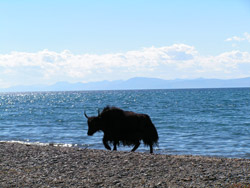 Mondy settlement. Mondy settlement.
Upon arrival at the border check-point we undergo through procedures required to cross the frontier from both sides of the border line. After completion of the procedure which will last about 1.5 hour we’re welcome to Mongolia!
Before reaching our ger-camp site we start realizing clearly that we’re already in a country that differs much from Russia though it’s only 20 km away. On our way to the yurt-camp site we shall enjoy our first impressions of Mongolia based on what we see- the Mongol gers (round-shaped felt yurts) and yaks, swiftly riding horsemen amidst alpine meadows, the snow topped peaks of Eastern Sayany mountain Range. And then within 1 hour of our drive from border check-up point we will all over sudden find ourselves in a small quite bay, on the shore of the Dark Blue Pearl of Mongolia –Lake Khovsgol ( click to know more…).
Here we check in cozy felt yurts of the Silver Coast Ger Camp, have dinner followed by orientation lecture on the upcoming journey.
 Burkhan Baabai or The Yellow Lord –is one of the major deities sent to the world by Father Tengeri to protect people from evil Oriental spirits. Sand of the White Mountain of Burkhan Baabai is thought to be holy and visitors usually take it back home to hang it above the entrance door as a protection from evil spirits. On the mountain slope there’s a white Craig with two openings resembling two bull fangs which are associated with presence here of Bukha Noyon. Bukha Noyon was turned into Lamaism and received the Buddhist name of Rinchin Khan ( meaning “precious” in Tibet).The holy mountain has two depictions of the Bukha Noyon – both Buddhist and shamanistic. Buddhist depict Bukha Noyon riding a white horse, while in shamanistic depiction of Bukha Noyon his male gender is emphasized for he is worshipped as a patron of birth and new generations. Burkhan Baabai or The Yellow Lord –is one of the major deities sent to the world by Father Tengeri to protect people from evil Oriental spirits. Sand of the White Mountain of Burkhan Baabai is thought to be holy and visitors usually take it back home to hang it above the entrance door as a protection from evil spirits. On the mountain slope there’s a white Craig with two openings resembling two bull fangs which are associated with presence here of Bukha Noyon. Bukha Noyon was turned into Lamaism and received the Buddhist name of Rinchin Khan ( meaning “precious” in Tibet).The holy mountain has two depictions of the Bukha Noyon – both Buddhist and shamanistic. Buddhist depict Bukha Noyon riding a white horse, while in shamanistic depiction of Bukha Noyon his male gender is emphasized for he is worshipped as a patron of birth and new generations. |
Day 3
July, 10 – the longest and most fascinating lake cruise of Mongolia
After breakfast we check out from our ger-camp for a 30-minutes ride by van to Hankh settlement (center of province - "aimag" in Mongolian) located on the shore of Lake Khovsgol connected with Lake Baikal by a rift zone and the river of Egiin gol (the only river to flow out from Khovsgol which then carries its waters to the Selenga river – the largest inflow of Lake Baikal). At Hankh we call on the park office and after completing all registry procedures required by regulations of Khovsgol National Park we’ll proceed to the boat station to board our motor vessel for a interesting journey along the shore of lake Khovsgol – from its northernmost point to the southernmost one- the entire route lying in the premises of Khovsgol National Park.
 Lake Khovsgol National Park covered by «Absolute Siberia Bureau» tour itineraries, was designated in 1995. Located in the Lake Khovsgol National Park covered by «Absolute Siberia Bureau» tour itineraries, was designated in 1995. Located in the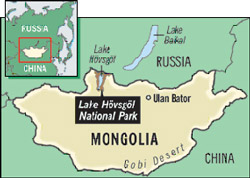 far north from Ulaan Baatar, next to the Siberian frontier, the Park includes 100,000 sq. Km of mountains, golden larch forest, verdant pasture and meadowland, profuse with wild flowers and laced with rivers of crystal waters. Open to foreign visitors for only ten years, since the end of Soviet influence in 1990, Mongolia's Khovsgol National Park is a land of complex environments and cultures. Being the country's most visited park, yet its annual budget is just $25,000. That covers only salaries and operating expenses, with nothing left over for improvements. Tourism could draw the needed dollars, but it could also adversely impact the unspoiled wilderness that attracts visitors in the first place. Even now, in heavily traveled areas along the lake, human impact is apparent: discarded bottles and candy wrappers litter the ground at campsites. However, sustainable tourism can be managed, and given the other pressures, tourism is the least damaging use. far north from Ulaan Baatar, next to the Siberian frontier, the Park includes 100,000 sq. Km of mountains, golden larch forest, verdant pasture and meadowland, profuse with wild flowers and laced with rivers of crystal waters. Open to foreign visitors for only ten years, since the end of Soviet influence in 1990, Mongolia's Khovsgol National Park is a land of complex environments and cultures. Being the country's most visited park, yet its annual budget is just $25,000. That covers only salaries and operating expenses, with nothing left over for improvements. Tourism could draw the needed dollars, but it could also adversely impact the unspoiled wilderness that attracts visitors in the first place. Even now, in heavily traveled areas along the lake, human impact is apparent: discarded bottles and candy wrappers litter the ground at campsites. However, sustainable tourism can be managed, and given the other pressures, tourism is the least damaging use. |
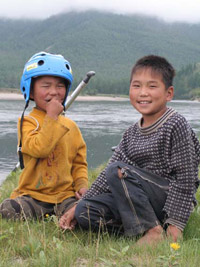 Lake Khovsgol, at 1645 m above sea level and 262 m deep, stretches 130 km from Khanh to Hatgal settlement at the southern tip up to the mountains of the Russian border in the north. During our Mongolian longest lake cruise in some of the purest fresh water in the world we’ll view Horidol Saridag Mountains along the western shore of the lake climbing to nearly 3,000m covered by fragrant conifer forests under an ocean canopy of the bluest sky you ever saw. During the cruise we will come close to the lake’s biggest island od Dalain Modon Khuis, 3 km long and 1.7 wide, which is associated with a number of legends. According to one legend when suddenly a mighty fountain of water started pouring from the hole under the earth here and soon flooding nearly all the surrounding mountains and pastures, the legendary Gesser knight would grab the biggest crag available and covered the hole… The water flow was stopped, and the area already flooded would turn into Lake Khovsgol. Lake Khovsgol, at 1645 m above sea level and 262 m deep, stretches 130 km from Khanh to Hatgal settlement at the southern tip up to the mountains of the Russian border in the north. During our Mongolian longest lake cruise in some of the purest fresh water in the world we’ll view Horidol Saridag Mountains along the western shore of the lake climbing to nearly 3,000m covered by fragrant conifer forests under an ocean canopy of the bluest sky you ever saw. During the cruise we will come close to the lake’s biggest island od Dalain Modon Khuis, 3 km long and 1.7 wide, which is associated with a number of legends. According to one legend when suddenly a mighty fountain of water started pouring from the hole under the earth here and soon flooding nearly all the surrounding mountains and pastures, the legendary Gesser knight would grab the biggest crag available and covered the hole… The water flow was stopped, and the area already flooded would turn into Lake Khovsgol.
With one stop on the way to have picnic lunch prepared for you over the camp-fire on the shore amidst picturesque natural setting it will take us about 7 hours to get by our motor boat to Hatgal, located in the southernmost point of Khovsgol, and originally founded in 1727 as a camp for Manchu soldiers defending their holdings from Russia. Upon arrival in Hatgal we’ll get our transfer to the MS Guest House for tasty dinner and overnight.
Day 4
July, 11 – the most festive day
After breakfast and easy short hike along the shore of the river of Egiin gol we set off to see the Naadam festival, or Eriyn Gurvan Nadaam ( The Three Manly Games). It is the biggest festival of the year for Mongolians. Usually, it runs for three days in all parts of the country and highlights the greatest athletes in horse racing, archery, and wrestling: Mongolia's most popular sports. Women participate in all but the wrestling category, and in horse racing even 4-year old kids can take part.
The period of Naadam is, perhaps, the happiest and most easy-going time of the Mongolian calendar for most of Mongols, but for some of them it means hard work, lots of sweat on the skin and dust in the eyes. In between the competitions today we will have lunch in one of the “guanz” ( Mongolian style roadside cafeteria inside the felt yurt).
Upon return from Naadam Festival the evening shall be spent on licensed fishing for black grayling or Siberian trout ( catch limit is 7 fishes, fishing tackles to be provided), and if you have good luck and catch fish our cook will bake it for you in a special way
Also at dinner we will taste Horhog Mongol National lam dish which is real tasty: you’ll eat your tongue. This meat dish with potatoes, carrots, turnips, onions, garlic, and some water is cooked in a large tightly closed pot together with red-hot rocks that is allowed to stand for half an hour, with meat and cooked thoroughly but tenderly by the compressed heat of the stones. Once the meat is cooked, the stones which are still hot are taken out and passed around: holding the hot stones is said to relieve tiredness and improve blood circulation, and just simply – making people who pass the stones to each other the team...
|
 Naadam festival has been held for centuries as a form of memorial celebration, as an annual sacrificial ritual honoring various mountain gods or to celebrate a community endeavor. Wrestling is but one of the three sports that make up Naadam, or "The Three Manly Games" as the full name runs in translation. The wrestlers have a very intriguing way of fighting - they lose the fight as soon as they touch ground with a knee, an elbow or the back. Therefore it is not only brute force that counts (jugding by weight, most of the wrestlers are impressive enough!) but far more tactics, patience, the gift of spotting the opponent's weak points and the capacity to launch surprise attacks forcing the opponent to lose balance. The other two sporting events are horse races and archery. These three sports are the fields where a true man can show his ability - at least in theory since in reality women and children participate in archery and horse racesideless kids 4-year old . Naadam festival has been held for centuries as a form of memorial celebration, as an annual sacrificial ritual honoring various mountain gods or to celebrate a community endeavor. Wrestling is but one of the three sports that make up Naadam, or "The Three Manly Games" as the full name runs in translation. The wrestlers have a very intriguing way of fighting - they lose the fight as soon as they touch ground with a knee, an elbow or the back. Therefore it is not only brute force that counts (jugding by weight, most of the wrestlers are impressive enough!) but far more tactics, patience, the gift of spotting the opponent's weak points and the capacity to launch surprise attacks forcing the opponent to lose balance. The other two sporting events are horse races and archery. These three sports are the fields where a true man can show his ability - at least in theory since in reality women and children participate in archery and horse racesideless kids 4-year old .
|
Day 5
July,12 – The Hundred Arms Tree
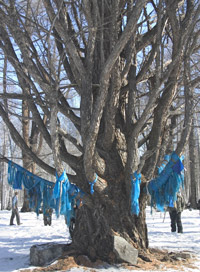 After breakfast we check out from our camp base in the settlement of Hatgal and drive to Tsagannuur (districtal center) which is located at the distance of 65 km from Hatgal. Before reaching this settlement we stop to see on of the most remarkable spots of Lake Khovsgol eastern shore – the so-called “Hundred Arms Tree” – a very spectacular larch tree associated with many interesting legends. The tree is said to have been grown from placenta of a female shaman once living in the local area. That shamanese would fail for very long time to successfully deliver her first babies –all of them fell out or would not survive after the delivery. So once during her interlocution with the spirits the latter told her that after the delivery of her next baby she has to bury the placenta into the earth. That was what she did, and out of it the “100-arms tree grew up. After breakfast we check out from our camp base in the settlement of Hatgal and drive to Tsagannuur (districtal center) which is located at the distance of 65 km from Hatgal. Before reaching this settlement we stop to see on of the most remarkable spots of Lake Khovsgol eastern shore – the so-called “Hundred Arms Tree” – a very spectacular larch tree associated with many interesting legends. The tree is said to have been grown from placenta of a female shaman once living in the local area. That shamanese would fail for very long time to successfully deliver her first babies –all of them fell out or would not survive after the delivery. So once during her interlocution with the spirits the latter told her that after the delivery of her next baby she has to bury the placenta into the earth. That was what she did, and out of it the “100-arms tree grew up.
Besides the unique tree itself here we shall a stone plate depicting Green Tora which is placed at the tree trunk . Until now the prejudiced Mongolian pregnant women come to this tree and embrace the trunk asking the spirits and Tora for successful delivery of their expected babies and their health. Those married men who happened not to have sons when passing by this tree are also likely to stop here and touching the tree trunk request the gods for an heir.
By the evening we set up a tent-camp to have dinner and overnight.
 Reverence for trees is an important part of Mongolian tradition. They especially revere large or unusual trees, which are believed to be the residence of powerful spirits. They may be honored by tying on pieces of cloth or placing offerings of tobacco to the spirit of the tree as they would pass during their travels. A tree symbolizes the world center, where heaven and earth touch, where all times and places converge. For this reason trees are considered to be places of prayer. On the “barisaa, "prayer tree”, -the Mongols tie ribbons, bud, onto its branches in honor of the spirits. The tying on of the ribbons is done with a specific intention for healing, luck, or some other purpose, and the spirits are believed to heed the intentions conveyed by the ribbons. Reverence for trees is an important part of Mongolian tradition. They especially revere large or unusual trees, which are believed to be the residence of powerful spirits. They may be honored by tying on pieces of cloth or placing offerings of tobacco to the spirit of the tree as they would pass during their travels. A tree symbolizes the world center, where heaven and earth touch, where all times and places converge. For this reason trees are considered to be places of prayer. On the “barisaa, "prayer tree”, -the Mongols tie ribbons, bud, onto its branches in honor of the spirits. The tying on of the ribbons is done with a specific intention for healing, luck, or some other purpose, and the spirits are believed to heed the intentions conveyed by the ribbons.
Trees are also symbolic of the world tree toroo, which is usually visualized as a birch or willow. The willow tree being associated with the world tree is interesting since the willow lives near water, which is considered in Siberian traditions as a traveling way for the spirits. In Mongolian tradition there is a belief in a world spirit river called Dolbor, which flows through all three worlds, passing by the world tree. The world tree represents an axis intersecting all three worlds, and where it touches earth is the world center, where all times, places, and potentialities converge. For this reason sacred trees are shamanically very powerful. The Mongols wooden oboo is a symbol of the world tree. Note the many ribbons tied on around it by worshipers. A similar tree, decorated, or simply cut and planted in the ground for the ceremony, was used in the shamanic initiation. |
Day 6
July, 13 – the first real “Mongolian” day
After lunch our guide will tell us about the tour covering Mongolian legendary and sacred places. We'll ride along Lake Khovsgol's western shoreline, surrounded by pastures of wildflowers and forests of larch and pine. With over two million acres of virtually uninhabited forests, mountain ranges and lush grasslands, much of the Khovsgol region is accessible only by horseback, so we'll often be blazing our own trail. Walk horseback does not demand additional preparation. You will get necessary skills on a place with the help of the skilled guide. All horses specially are trained. Walk goes in slow rate.
After supper before bedtime we shall be told different stories and mysteries - "uliger-tales" about the surroundings and about the traditions of the Mongols.
 Uliger- tales, are an important part of oral traditions among the Mongolians and other Siberian peoples. In fact they are known as uliger in several Siberian languages as well as in Mongolian. The purpose of these tales are to explain why the world today is the way it is, such as in the myths about Angara and of the evergreen trees. Other uliger, such as the ones about tobacco and alcohol, help convey social values about appropriate behavior. Longer myths, such as those of Geser and Nishan, were important vehicles for the transmission of shamanic traditions. The setting for the telling of these tales was usually around the fire in the winter. Under normal circumstances uliger are only told in the wintertime; if they are told in the summer it may cause winter weather to return. The Geser legends, however, may be told at any time of the year if done in connection with shamanic ritual, for it is believed that it brings shamanic power, good luck, and healing in its telling. Uliger- tales, are an important part of oral traditions among the Mongolians and other Siberian peoples. In fact they are known as uliger in several Siberian languages as well as in Mongolian. The purpose of these tales are to explain why the world today is the way it is, such as in the myths about Angara and of the evergreen trees. Other uliger, such as the ones about tobacco and alcohol, help convey social values about appropriate behavior. Longer myths, such as those of Geser and Nishan, were important vehicles for the transmission of shamanic traditions. The setting for the telling of these tales was usually around the fire in the winter. Under normal circumstances uliger are only told in the wintertime; if they are told in the summer it may cause winter weather to return. The Geser legends, however, may be told at any time of the year if done in connection with shamanic ritual, for it is believed that it brings shamanic power, good luck, and healing in its telling. |
Day 7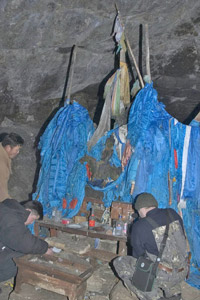
July, 14 – the most spiritual day
After having breakfast and getting our luggage packed on pack horses we start out for our horse ride to the holy of holies – Dayan Degereki. During this horseback portion of the trip our group will spend delightful 2-3 hours admiring from horseback the natural beauty and remote wilderness setting of Mongolia.
The cave Dayan Degereki is the largest and the least explored cave in Mongolia. The narrow gate in the 1st hall lets get into the halls of the 2nd stage arterial into a maze. But the whole sanctuary Dayan Degereki is in the 1st room near the cave entrance. The center place of sanctuary is occupied by the altar where there is a wooden figure of a horseman dressed in the conventional Mongolian clothes with a heap of arrows behind. His hair is crowned with a beam of lightnings. It is Dayan Degereki himself. And in front of him we see sacrificial gifts – cheese, cream, curds, biscuits, sweets, matches, vodka in cups and lamp-oil. On making our own gifts we leave the cave silently and respectfully…
Our group will overnight in tents and in the evenings watch the stars decorating the velvet sky hundreds of miles from any city. Tasty meals will be prepared by our cook over camp fire.
|
 The origin of Mongolian shamanism is rendered by a traditional account from the Chahar region, undoubtedly of an aetiological nature - that is, an old myth attempting to explain the existence of a still older ritual behavior - which underscores the importance of the ancestor cult and the shaman's role as a socio-religious mediator. Shamanism was born in Mongolia, according to native legend, through the will of ancestral spirits, ecstatic seizures, and flying horses (the shamans' drums). Mountain tops have been the dwelling places of deities and spirits. However, in the face of the awesomeness exuded by the high sanctity of such places, coming from the numen of the residing supernatural beings, it is forbidden to utter the name of such a sacred mountain. The shamanistic attributes, if not origins, of the cult of the mountain gods can be observed unequivocally in the northwest corner of Mongolia, near the lake of Khoso Gol, where the shamans and other religious suppliants have venerated the mountain god, Khan Boghda Dayan Degereki Khayirkhan, in the form of the holy mountain. The designation khayirkhan, meaning "the loved, the beautiful," is a euphemistic allusion to this sacred topographic outcrop. The origin of Mongolian shamanism is rendered by a traditional account from the Chahar region, undoubtedly of an aetiological nature - that is, an old myth attempting to explain the existence of a still older ritual behavior - which underscores the importance of the ancestor cult and the shaman's role as a socio-religious mediator. Shamanism was born in Mongolia, according to native legend, through the will of ancestral spirits, ecstatic seizures, and flying horses (the shamans' drums). Mountain tops have been the dwelling places of deities and spirits. However, in the face of the awesomeness exuded by the high sanctity of such places, coming from the numen of the residing supernatural beings, it is forbidden to utter the name of such a sacred mountain. The shamanistic attributes, if not origins, of the cult of the mountain gods can be observed unequivocally in the northwest corner of Mongolia, near the lake of Khoso Gol, where the shamans and other religious suppliants have venerated the mountain god, Khan Boghda Dayan Degereki Khayirkhan, in the form of the holy mountain. The designation khayirkhan, meaning "the loved, the beautiful," is a euphemistic allusion to this sacred topographic outcrop.
|
Day 8
July, 15 – the most salubrious day
After lunch we depart to Tsan Uur. En route we stop at ancient petroglyphs depicting deer. Not far from it there is a small settlement of 5 yurts where we have dinner. Then we continue our way to Bulnaisky hot wells, the most famous on Khovsgol and in Mongolia.
In the evening we achieve our destination of the day near the White river. From the time immemorial these hot wells are known with their healing power. Even in winter they keep the temperature of 35 to 72 degrees centigrade. Here at a certain distance from the wells we set up our camp, investigate outskirts, visit the wells themselves and meet the Mongols – voluntary wells guards who can tell us a lot of interesting things. And should you find it necessary to have a bathe in the hot wells, you are welcome!
Day 9
July, 16 – the most panoramic day
After lunch we strike our camp and depart to Khovsgol enjoying its sights and taking pictures. Within Mongolia, Khovsgol is renowned for its scenic beauty. Mountains ranging as high as 12,000 feet are interspersed with wide grassy valleys and clear rivers. Khovsgol is the northernmost province (aimag) of Mongolia and lies on the border with Siberia and Tuva. Khovsgol Lake, second largest body of freshwater in the world, is the centerpiece of a national park. The region is famous for game and fish including elk, bear, wild boar, ibex, marmot, salmon, grayling and a member of the trout family called lenok. And before supper we will take part in licensed fishing competition the winner of which will get a special prize from "Absolute Siberia".
|
 Lake Khovsgol is viewed as a key biosphere for species that have disappeared elsewhere in the world. Lake Khovsgol is viewed as a key biosphere for species that have disappeared elsewhere in the world. 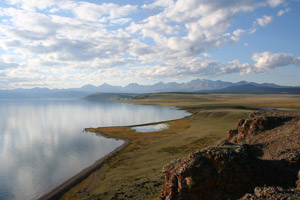 President of Mongolia N.Bagabandi has called Lake Khovsgol Mongolia's treasure. Tourists, who flock to the area after hearing about this beautiful lake by the same name, call it Mongolia's Switzerland. With 70 percent of Lake KKhovsgol's water beneath 100 meters, bottoming out at 262, the lake is Central Asia's deepest; and home to two percent of the world's fresh water. It has remained remarkably free of pollution, and its waters are as clear as spring water. Fish, including ruff and salmon, can be easily seen swimming year round. 96 rivers and streams flow out of KKhovsgol, among them the Egiin river, which then joins the Selenge along its eventual path to Lake Baikal. Indeed, the KKhovsgol's flora and fauna closely resemble that found in its northern neighbor.The lake has 4 islands- Khadan khuis, Modon khuis, Dalai khuis and Baga khuis. The largest is Dalait khuis (6 square km), and is covered with forest. President of Mongolia N.Bagabandi has called Lake Khovsgol Mongolia's treasure. Tourists, who flock to the area after hearing about this beautiful lake by the same name, call it Mongolia's Switzerland. With 70 percent of Lake KKhovsgol's water beneath 100 meters, bottoming out at 262, the lake is Central Asia's deepest; and home to two percent of the world's fresh water. It has remained remarkably free of pollution, and its waters are as clear as spring water. Fish, including ruff and salmon, can be easily seen swimming year round. 96 rivers and streams flow out of KKhovsgol, among them the Egiin river, which then joins the Selenge along its eventual path to Lake Baikal. Indeed, the KKhovsgol's flora and fauna closely resemble that found in its northern neighbor.The lake has 4 islands- Khadan khuis, Modon khuis, Dalai khuis and Baga khuis. The largest is Dalait khuis (6 square km), and is covered with forest.
|
Day 10
July, 17 – the last “water” sensation of Khovsgol and its sources
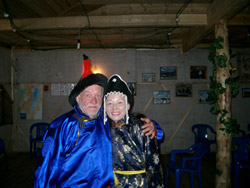 After breakfast we board our boat vessel "Nomads” for a transfer back to the north – to Hankh. During our voyage we enjoy Khordil Saridag mountain and other picturesque landscapes. The Khordil Saridag, a special Protected Area, adjoins the Lake Khovsgol National Park, making the region an important area for wildlife. There is huge diversity of wildflowers and birds in the National Park, including a number of rare species. En route we stop at one of the loveliest bays to picnic Khovsgol ashore. After breakfast we board our boat vessel "Nomads” for a transfer back to the north – to Hankh. During our voyage we enjoy Khordil Saridag mountain and other picturesque landscapes. The Khordil Saridag, a special Protected Area, adjoins the Lake Khovsgol National Park, making the region an important area for wildlife. There is huge diversity of wildflowers and birds in the National Park, including a number of rare species. En route we stop at one of the loveliest bays to picnic Khovsgol ashore.
On return to Hankh we are accommodated at “Posledny Rubez” where Russian banya with kvass and farewell supper with strong drinks are awaiting us. And every tourist having been to Khovsgol gets a special certificate “Khovsgol sources” and a souvenir from “Absolute Siberia Bureau”.
Day 11
July, 18 – the day of return and commemoration
After lunch we leave Hankhl and depart to Russo-Mongolian border. On crossing it we are likely to see at once that we are in Russia. But passing by Burkhan Baabai we recollect Dayan Degereki, commemorate spirits and wish our relatives and friends good luck.
En route we stop to have dinner on the shore of Lake Baikal and further proceed along the beautiful Tunka Valley, the most picturesque place to the South from Lake Baikal, the continuation of Baikal depression. It stretches for 200 km with the elevation gradually rising from 550 to 1200 meters above sea level. The Tunkinsky National Park was founded here in 1991. The whole valley territorially belongs to the Park, and it is known for its mineral spring spas. The most famous are Arshan, Zhemchug and Nilova Pustyn.
Dinner and overnight at hotel in Irkutsk.
Day 12
July, 19 – the most comparative day
Today again we will have a nice possibility to compare the two Greatest Lakes and in spite of obvious superiority of the Baikal find much in common. we drive to 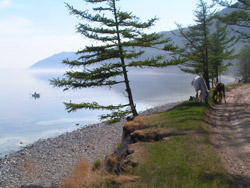 Lystvyanka to stop in the source of the Angara River from Lake Baikal near the Shamanka Rock associated with many popular legends. After taking pictures here and learning about some ancient customs of local people we visit Baikal Ecology Museum which has a large display of unique exhibits of the lake’s flora and fauna as well as here we visit the Aquarium to see Lake Baikal fresh water seals that still remain a mystery of Lake Baikal to be unraveled ( scientists still argue how the seals from their native Arctic ocean managed to penetrated this lake located amidst the Asiatic continent. Lystvyanka to stop in the source of the Angara River from Lake Baikal near the Shamanka Rock associated with many popular legends. After taking pictures here and learning about some ancient customs of local people we visit Baikal Ecology Museum which has a large display of unique exhibits of the lake’s flora and fauna as well as here we visit the Aquarium to see Lake Baikal fresh water seals that still remain a mystery of Lake Baikal to be unraveled ( scientists still argue how the seals from their native Arctic ocean managed to penetrated this lake located amidst the Asiatic continent.
Then we drive by coach to an observation sight from where one can enjoy and take pictures of excellent views on Lake Baikal . After lunch of tasty Siberian cuisine served at the waterfront restaurant we then also visit popular functioning St. Nicolas-the-Miracle-Worker Russian Orthodox Church built of wood without use of any nail. Here you may buy a candle and lit it placing before the main church icon asking the Wonder-Maker Saint for luck.
Then we return to Irkutsk where you have some spare time to spend as you like it and our guide will be
always of assistance to you. Dinner and overnight at hotel in Irkutsk.
Day 13
July, 20 – the final day
Transfer from the hotel to the airport or railway station and then farewell - “Absolute Siberia Bureau” wishes you good luck and new pleasant discoveries!
|




 On checking the availability of passports and entrance visas we start out by van to the Kultuk settlement, located 110 km away from Irkutsk. With one stop en route to take pictures of splendid views of taiga-woods and scenic lake Baikal in about 1 hour 20 minutes we reach the lake’s southernmost settlement founded by early Russian explorers in 1654. From Kultuk we follow the highway into the beautiful Tunka ( or Tunkinskaya) Valley – the native land of Gesser, a hero from famous Buryat National Epic which ancient mythology, perhaps, is the key to understanding the intricate cosmology of Buryat shamanism.
On checking the availability of passports and entrance visas we start out by van to the Kultuk settlement, located 110 km away from Irkutsk. With one stop en route to take pictures of splendid views of taiga-woods and scenic lake Baikal in about 1 hour 20 minutes we reach the lake’s southernmost settlement founded by early Russian explorers in 1654. From Kultuk we follow the highway into the beautiful Tunka ( or Tunkinskaya) Valley – the native land of Gesser, a hero from famous Buryat National Epic which ancient mythology, perhaps, is the key to understanding the intricate cosmology of Buryat shamanism. Mondy settlement.
Mondy settlement. far north from Ulaan Baatar, next to the Siberian frontier, the Park includes 100,000 sq. Km of mountains, golden larch forest, verdant pasture and meadowland, profuse with wild flowers and laced with rivers of crystal waters. Open to foreign visitors for only ten years, since the end of Soviet influence in 1990, Mongolia's Khovsgol National Park is a land of complex environments and cultures. Being the country's most visited park, yet its annual budget is just $25,000. That covers only salaries and operating expenses, with nothing left over for improvements. Tourism could draw the needed dollars, but it could also adversely impact the unspoiled wilderness that attracts visitors in the first place. Even now, in heavily traveled areas along the lake, human impact is apparent: discarded bottles and candy wrappers litter the ground at campsites. However, sustainable tourism can be managed, and given the other pressures, tourism is the least damaging use.
far north from Ulaan Baatar, next to the Siberian frontier, the Park includes 100,000 sq. Km of mountains, golden larch forest, verdant pasture and meadowland, profuse with wild flowers and laced with rivers of crystal waters. Open to foreign visitors for only ten years, since the end of Soviet influence in 1990, Mongolia's Khovsgol National Park is a land of complex environments and cultures. Being the country's most visited park, yet its annual budget is just $25,000. That covers only salaries and operating expenses, with nothing left over for improvements. Tourism could draw the needed dollars, but it could also adversely impact the unspoiled wilderness that attracts visitors in the first place. Even now, in heavily traveled areas along the lake, human impact is apparent: discarded bottles and candy wrappers litter the ground at campsites. However, sustainable tourism can be managed, and given the other pressures, tourism is the least damaging use. Lake Khovsgol, at 1645 m above sea level and 262 m deep, stretches 130 km from Khanh to Hatgal settlement at the southern tip up to the mountains of the Russian border in the north. During our Mongolian longest lake cruise in some of the purest fresh water in the world we’ll view Horidol Saridag Mountains along the western shore of the lake climbing to nearly 3,000m covered by fragrant conifer forests under an ocean canopy of the bluest sky you ever saw. During the cruise we will come close to the lake’s biggest island od Dalain Modon Khuis, 3 km long and 1.7 wide, which is associated with a number of legends. According to one legend when suddenly a mighty fountain of water started pouring from the hole under the earth here and soon flooding nearly all the surrounding mountains and pastures, the legendary Gesser knight would grab the biggest crag available and covered the hole… The water flow was stopped, and the area already flooded would turn into Lake Khovsgol.
Lake Khovsgol, at 1645 m above sea level and 262 m deep, stretches 130 km from Khanh to Hatgal settlement at the southern tip up to the mountains of the Russian border in the north. During our Mongolian longest lake cruise in some of the purest fresh water in the world we’ll view Horidol Saridag Mountains along the western shore of the lake climbing to nearly 3,000m covered by fragrant conifer forests under an ocean canopy of the bluest sky you ever saw. During the cruise we will come close to the lake’s biggest island od Dalain Modon Khuis, 3 km long and 1.7 wide, which is associated with a number of legends. According to one legend when suddenly a mighty fountain of water started pouring from the hole under the earth here and soon flooding nearly all the surrounding mountains and pastures, the legendary Gesser knight would grab the biggest crag available and covered the hole… The water flow was stopped, and the area already flooded would turn into Lake Khovsgol.
 After breakfast we check out from our camp base in the settlement of Hatgal and drive to Tsagannuur (districtal center) which is located at the distance of 65 km from Hatgal. Before reaching this settlement we stop to see on of the most remarkable spots of Lake Khovsgol eastern shore – the so-called “Hundred Arms Tree” – a very spectacular larch tree associated with many interesting legends. The tree is said to have been grown from placenta of a female shaman once living in the local area. That shamanese would fail for very long time to successfully deliver her first babies –all of them fell out or would not survive after the delivery. So once during her interlocution with the spirits the latter told her that after the delivery of her next baby she has to bury the placenta into the earth. That was what she did, and out of it the “100-arms tree grew up.
After breakfast we check out from our camp base in the settlement of Hatgal and drive to Tsagannuur (districtal center) which is located at the distance of 65 km from Hatgal. Before reaching this settlement we stop to see on of the most remarkable spots of Lake Khovsgol eastern shore – the so-called “Hundred Arms Tree” – a very spectacular larch tree associated with many interesting legends. The tree is said to have been grown from placenta of a female shaman once living in the local area. That shamanese would fail for very long time to successfully deliver her first babies –all of them fell out or would not survive after the delivery. So once during her interlocution with the spirits the latter told her that after the delivery of her next baby she has to bury the placenta into the earth. That was what she did, and out of it the “100-arms tree grew up.

 After breakfast we board our boat vessel "Nomads” for a transfer back to the north – to Hankh. During our voyage we enjoy Khordil Saridag mountain and other picturesque landscapes. The Khordil Saridag, a special Protected Area, adjoins the Lake Khovsgol National Park, making the region an important area for wildlife. There is huge diversity of wildflowers and birds in the National Park, including a number of rare species. En route we stop at one of the loveliest bays to picnic Khovsgol ashore.
After breakfast we board our boat vessel "Nomads” for a transfer back to the north – to Hankh. During our voyage we enjoy Khordil Saridag mountain and other picturesque landscapes. The Khordil Saridag, a special Protected Area, adjoins the Lake Khovsgol National Park, making the region an important area for wildlife. There is huge diversity of wildflowers and birds in the National Park, including a number of rare species. En route we stop at one of the loveliest bays to picnic Khovsgol ashore. Lystvyanka to stop in the source of the Angara River from Lake Baikal near the Shamanka Rock associated with many popular legends. After taking pictures here and learning about some ancient customs of local people we visit Baikal Ecology Museum which has a large display of unique exhibits of the lake’s flora and fauna as well as here we visit the Aquarium to see Lake Baikal fresh water seals that still remain a mystery of Lake Baikal to be unraveled ( scientists still argue how the seals from their native Arctic ocean managed to penetrated this lake located amidst the Asiatic continent.
Lystvyanka to stop in the source of the Angara River from Lake Baikal near the Shamanka Rock associated with many popular legends. After taking pictures here and learning about some ancient customs of local people we visit Baikal Ecology Museum which has a large display of unique exhibits of the lake’s flora and fauna as well as here we visit the Aquarium to see Lake Baikal fresh water seals that still remain a mystery of Lake Baikal to be unraveled ( scientists still argue how the seals from their native Arctic ocean managed to penetrated this lake located amidst the Asiatic continent.




